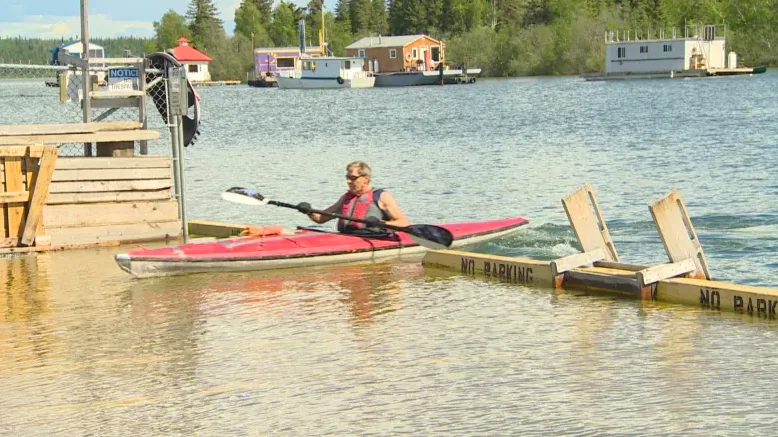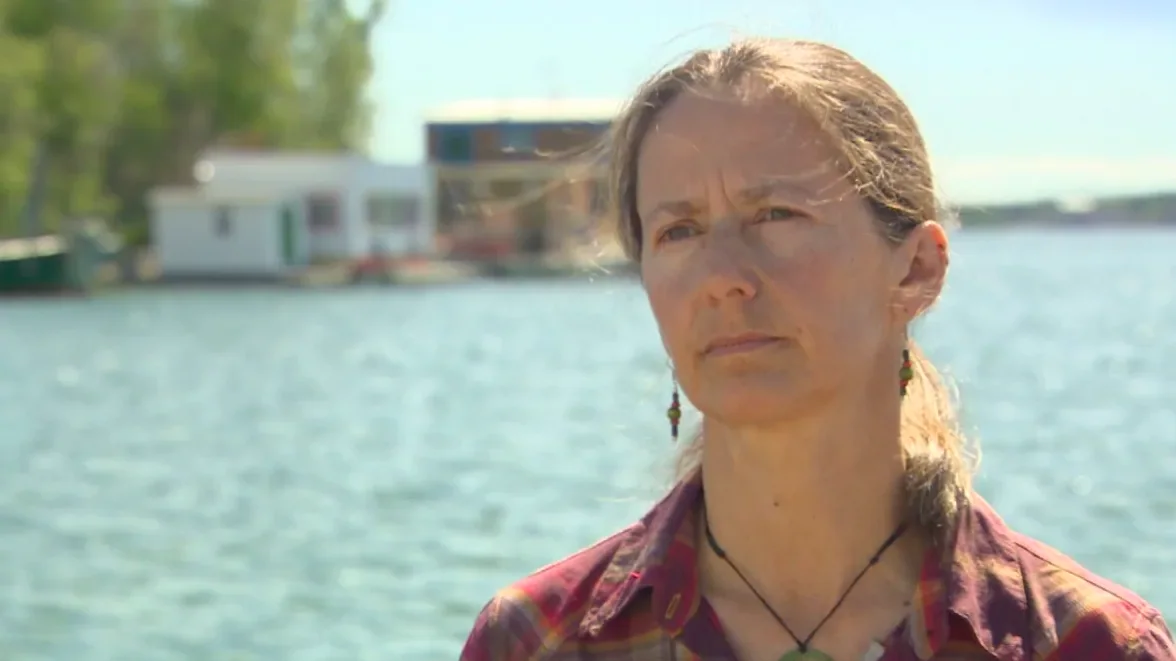
Canada's deepest lake reaches record high water levels
Private docks around Yellowknife are bobbing off their pilings and kayakers can paddle from Great Slave Lake directly onto parts of the government dock in Old Town where people sometimes sit in vehicles watching the boats go by.
"The Big Lake," as it is known locally, is as high as it has ever been recorded this year and so are a lot of other lakes and rivers in the southern Northwest Territories.
"I've had to move the dock in about 15 feet this year from where it was last year," said Cathy Allooloo, owner of Narwal Adventures on Back Bay. "But that being said, over the previous three, four, five years, I've been pushing it out, pushing it out. So now it's kind of back to where it originally was."
Allooloo has been living a stone's throw from water's edge for 30 years. She said there are many factors that influence the level of the lake. A wind from the south, like there was for almost a week, will push water to the north side, where Yellowknife is, causing a rise in the lake.

A kayaker paddles from Great Slave Lake directly onto the government dock in the Old Town neighbourhood of Yellowknife. (CBC photo)
WATER LEVEL MEETS RECORD
Hydrologist Shawne Kokelj said that on Wednesday the gauge in Yellowknife Bay registered 157 metres above sea level, equalling the highest level recorded for June 24 since 1972. That's the cutoff year for data that hydrologists use when looking at lake levels on Great Slave Lake because it is the year the flow of one of the major tributaries feeding into the lake, the Peace River, began being regulated for hydroelectric dams.
The lake is 26 centimetres above its average level for June 24. It has reached that level on that day only four times before: in 1974, 1991, 1992 and 1997.
The difference is even starker compared with last June, when water levels were the lowest they've been in the last 10 years. Yellowknife Bay is more than half a meter higher than it was this time last year. As high as it is, the lake is still 14 centimetres lower than the highest level recorded on any day of the year.
Kokelj said the high levels are the result of a coincidence of factors, including a reconnection of lakes and ponds that once drained into Great Slave Lake but were isolated during low water years.
"For the most part lakes and rivers in the southern N.W.T. have recovered from the dry period we saw between about 2014 to 2016, which means that some of the contributing basins within those areas have reconnected to the main stem," said Kokelj.

Hydrologist Shawne Kokelj says that on Wednesday, Great Slave Lake tied a record high level for that day of the year. Heavy snows in the mountains of B.C. and Alberta and a snap melt this year have contributed to the record water levels. (CBC photo)
LATE, SUDDEN SPRING CONTRIBUTED TO HIGH LEVELS
Kokelj said a lot of the water that feeds into Great Slave Lake and other N.W.T. basins, such as the Liard and Hay Rivers, flows from northern B.C., northern Alberta, southern Yukon and even northern Saskatchewan, which recorded higher than average snowfall last winter.
The late and sudden spring this year has also contributed.
"We also then had a very short snow melt period," said Kokelj. "Everything was delayed in all of these jurisdictions. So it's coming in a much more rapid pulse."
Kokelj said high water advisories issued for the Athabasca and Peace Rivers in Alberta in April were lifted last week.
Whenever there are unusually high or low water levels in Great Slave Lake, one of the first things people wonder about is the W.A.C. Bennett Dam. That's the massive hydroelectric dam on the Peace River in B.C., which eventually feeds into Great Slave Lake.
Kokelj said that since the dam was built, water levels on Great Slave Lake typically rise in winter, a time when they would naturally fall. She said they increased slightly more than normal this past winter, but that other influences are contributing more to the high water levels now.
"We're seeing [the rise in water levels] not only in a managed basin. There are others — the Liard the Hay — that are all showing indications of high water."
Though the unusually high water may be causing havoc with some docks, Allooloo said it does not have any impact on her canoeing and kayaking business.
"The water is the boss. The water does what it does," said Allooloo. "We adapt."
Story by Richard Gleeson, originally published on CBC.ca.





